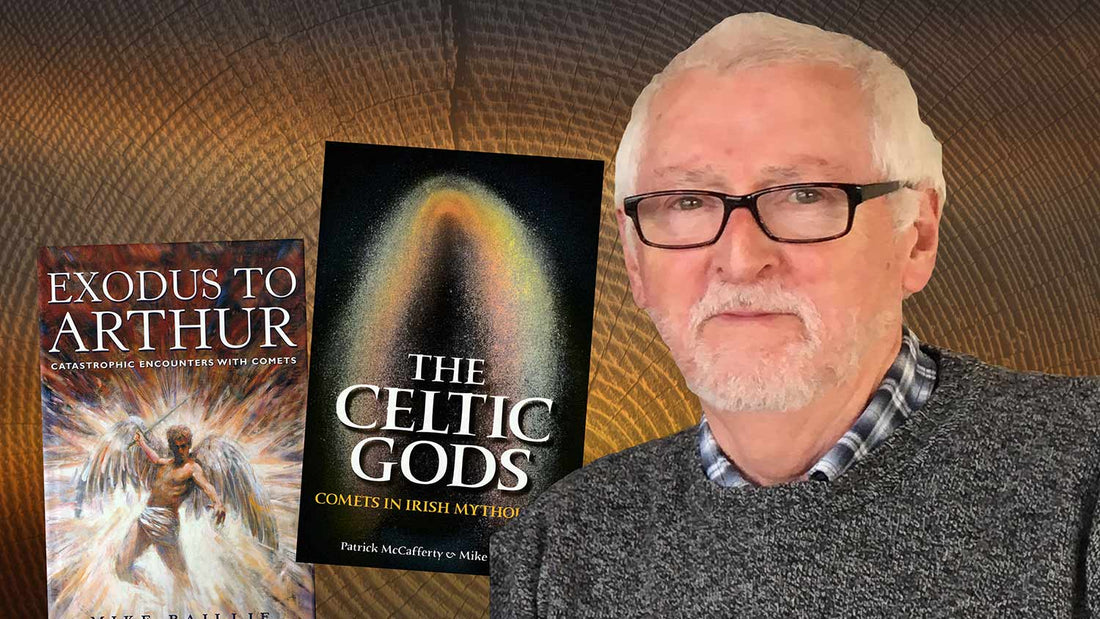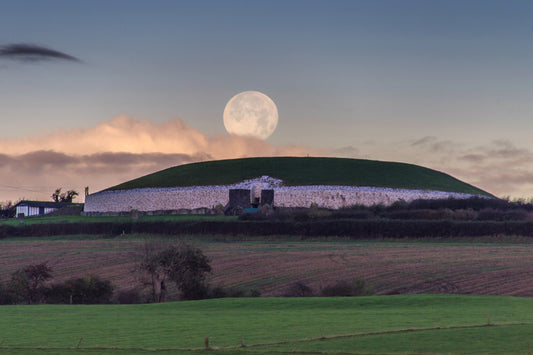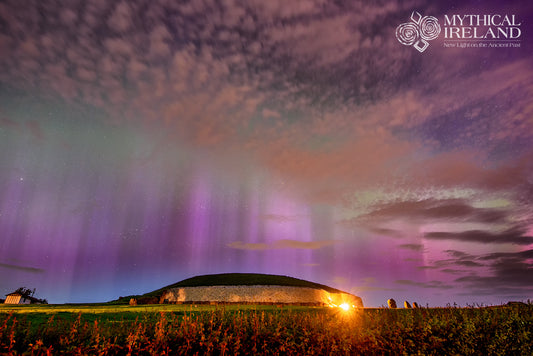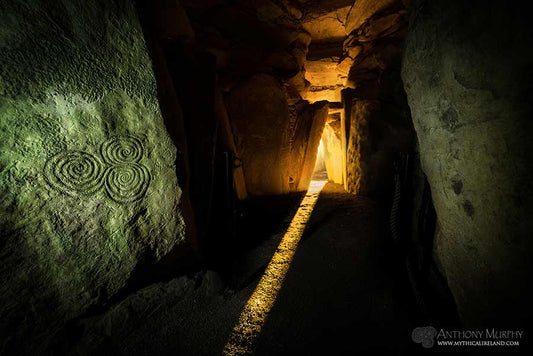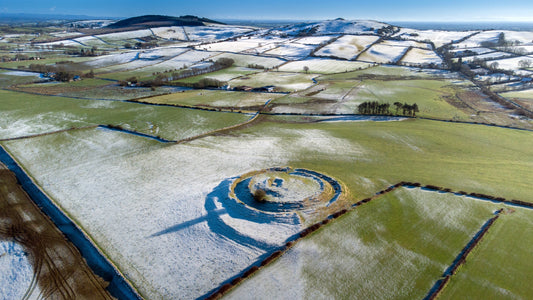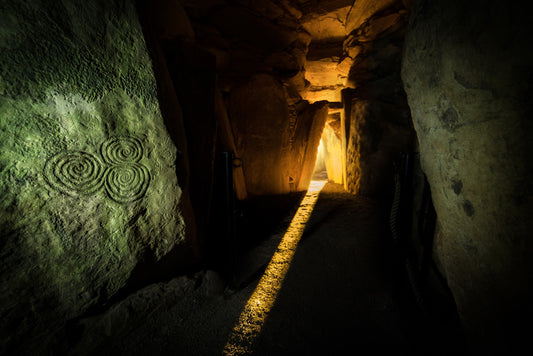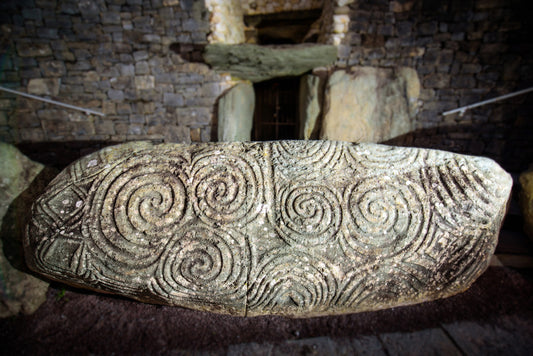The following is a transcript of a conversation I had with Mike Baillie of Queen’s University, one of the foremost experts on dendrochronology. The study of tree rings in Irish oaks has revealed much about the past, specifically a series of catastrophic climate events which may have been recorded in history and in mythology.
What is dendrochronology and how did you get involved in it?
My maths weren’t good enough to pursue a career in physics. By chance, I discovered archaeology. I ended up being taken up in the paleoecology department of Queen’s University Belfast to look into the possibility of building up a tree-ring chronology. To get a tree-ring chronology together and to get it precise, you need a scientific point of view. I started to build that chronology. Queen’s had bought a radiocarbon laboratory to date peat sequences from peat bogs. So there was a great deal of interest in the environment of the last ten thousand years. John Pilcher had noticed a lot of bog oaks in the land, after drainage for farming. Eventually they were just reburied or burned. John and I got a chainsaw and started cutting slices out of bog oaks. We also started accumulating living trees from oaks that were being cut down on estates.

A graphic expaining dendrochronology. Source: Professor Dave Explains
The idea was to try to build a chronology from the present back for thousands of years by overlapping the ring patterns. You start off with trees of a single species, in our case oak, and then overlap the ring patterns from living trees with trees from archaeological sites and then bogs. We collected lots of samples. We worked out that we could measure the tree-ring patterns and match them up in graphs. We wrote a computer program so that if we couldn’t cross-match tree-ring patterns by eye, where the computer said they did match we vetoed that. That worked the other way around too. If we thought we saw a match and the computer couldn’t find it, then we vetoed that. So we only accepted matches where the human and computer both agreed. That worked nearly perfectly, and gradually over a few years we had a thousand-year chronology, eventually a two-thousand-year chronology – using, for example, material from the Dublin excavations at Christchurch (Wood Quay) and also a whole series of horizontal mill timbers that turned up right across Ireland because of all the drainage that was going on. The timbers survived because they were in the stream bed and therefore wet.
We had acres of oak samples. We have in excess of ten thousand samples now. If we could build up a chronology of thousands of years, which we did, we could then take samples of exactly known-age wood out of our chronology and give it to the radiocarbon laboratory and they could measure the radiocarbon age, and that of course is the calibration process – you’re calibrating radiocarbon against tree rings which are absolutely dated. That was the aim.

A graphic explaning tree ring chronology. Source: Professor Dave Explains
Was this a new science or just new to Ireland?
We were the first people in Ireland to try it. There had been almost no work in the British Isles. There had been a thousand-year chronology built in Germany, and the home of dendrochronology had been the American Southwest. There’s a big laboratory in Tucson, Arizona, where they had built very long chronologies from sequoias, the giant redwoods in California, and also from bristlecone pine which grew at very high altitudes and where individual trees can survive for up to five thousand years.
The oaks we sampled had a typical lifespan of around two hundred to two-hundred-and-fifty years, so we had to make a lot of these overlaps. But the good thing about it was that we had lots and lots of samples, and that meant we had the opportunity to replicate things.
How far back do we now have a record for in tree-ring chronology?
In Ireland, the chronology that we finally published once we had it complete went back to 5289BCE, and was seven-thousand two-hundred years long. It has now been extended even further back, by about another two centuries. It covers all the interesting periods of Irish archaeology.
Does the preservation of old oaks depend on climate and/or latitude?
There’s very extensive use of oak right across Germany and even further east, so it’s pretty widespread in Europe. If you go further north into Scandinavia, most of the chronologies are conifers or pine trees, and they survive just as well in lakes as oaks do in bogs in Ireland.

An Irish bog oak. Source: Celtic Bogwoods.
How long did it take to put the ten thousand samples into one chronology?
It took from 1968 to about 1982. It took 14 years. But then in order to check it finally, we started collaborating with German colleagues who had an equivalent chronology and once we were able to show that the two chronologies agreed, that’s when we published our work in 1984.
Did you see regional events in the chronology? For example, were there narrowing or widening events in Ireland that weren’t replicated in Germany?
When you have established a chronology with Irish oaks, you’ll find that it cross-matches really well with English oaks, and the English oaks match quite well with German oaks. However, the Irish oaks don’t match quite as well with Germany so there’s a gradation because Germany is much more continental than Ireland. And if you grew up in Belfast you’d know that the weather used to be tremendously wet. I maintain that I didn’t see the sun until I was eight! And if you listened to the BBC, you’d hear that they were sweltering in heat down in southeast England!
If you’re digging a bog and you happen to dig up a bog oak, what age are these trees in the bog? They’re hardly likely to be less than a thousand years old, are they?
The vast majority of bog oaks are, on average, about 3000BCE. In fact, they run right back to 5400BCE, and they thin out dramatically around about the change of era – around the time of Christ. There’s only a trickle of bog oaks in the AD period compared with the vast numbers which are prehistoric.
What about oaks that were preserved in places other than bogs, for instance the Corlea Trackway? Why is Corlea important from an archaeological and a dendrochronological viewpoint?
For many years, we were acquiring timbers to build a chronology. Once we had the chronology more or less complete, if somebody turned up timbers from a monument such as a crannog or a trackway, we could date them for the archaeologists. It was a symbiotic relationship where we were getting samples and they were getting dates, and everyone was happy. A paleoecologist who was doing pollen work on Corlea bog noticed this trackway was being uncovered in the peat digging, and he sent a sample up to Belfast. We couldn’t date that single sample. It was broadly believed that these trackways were made of split oak trunks three metres long laid side by side across a bog – a huge undertaking. One timber from that enormous two-kilometre-long trackway came up and we couldn’t date it, so we got in the car one day with a chainsaw and went down and we cut a selection of samples. As soon as we had four ring patterns cross-matched, we were able to ascertain the dates very quickly. There were very high correlation values against the master chronology, and it dated to 147BC. I thought that was interesting because that was the only known second century BCE site on the island of Ireland.

Part of the Corlea Trackway is preserved at a visitor centre in Co. Longford. Photo: Discover Ireland.
I sent a postcard to the archaeologists in Dublin and suggested that they should send someone out to record the trackway. The postcard was sent to Victor Buckley, who was in the archaeological survey of the National Monuments Service. Victor asked Barry Raftery, a well-known archaeologist, to go to Corlea to excavate a section, and while Barry was out digging the trackway, they found 36 other tracks in the same bog – not all of the same scale; some were smaller and made of brushwood.
This all caused enough excitement that within a year an archaeological wetland unit was formed for the Irish Republic.
There’s a possibility that the Corlea Trackway is mentioned in mythology, isn’t that right?
Richard Warner, then in the Ulster Museum, picked up on this. In the Irish tale The Wooing of Étaín (Tochmarc Étaín), there’s a description of the building of an enormous trackway, the best the world had ever seen. The strange thing is that the dates given for the king who was reigning at that time and who was responsible for the building of the trackway were something like 140 to 100 BCE – close enough to the dendro date to make you think that there might have been a folk memory of the building of this trackway.
I’ve seen enough to suggest that there is a core of truth in the mythology.
There’s a significant narrowing in the tree-ring chronology from 1159 to 1141 BCE, which began really quite abruptly in 1159 BCE. And what intrigued me was that, in the story of the building of this trackway, there’s the mention – almost casually – of a thousand and twelve years between two events. And if you add 1,012 to 147BCE you get 1159BCE, so it’s almost like they knew of an event that took place 1,012 years previously. It’s the sort of thing I find slightly intriguing.
What was the nature of that environmental event beginning in 1159BCE?
By 1984, we had published the ‘Belfast chronology’, and in a sense we were out of a job! Our work was done. We had provided the samples to the radiocarbon lab, the calibration results had been measured and they were actually published in 1986. When you’re out of a job, you look around for other things to do. (We weren’t really out of a job because we still worked for the university). One of the things we did was to establish a commercial dating service for archaeologists and paleoecologists.
But we also had this long chronology and we’d never really looked at it in detail. This is Ireland, where nothing bad ever happens environmentally. It never gets hot, it never gets cold; sometimes it gets a bit wet, but nothing of any consequence ever happens.
It just so happened that two Americans published details of an event at 1627BCE in bristlecone pines and they were pretty sure that it was such a severe frost event in the growing season that it had to be triggered by a major volcanic eruption. They suggested that eruption was Santorini (an island in the Aegean Sea). When they published that, I looked at our tree ring chronology across 1627BCE and – lo and behold, as they say – there was a severe downturn in oak growth in Ireland in the same year. In fact, it started in one tree the year before, so I call it the ‘1628BCE event’.
I began to look at how unusual these very narrow tree-ring events were. That gave rise to a piece of work because a series of dates stood out of the oak chronology which include the ‘centre dates’ of 3195BCE, 2345BCE, 1628BCE, 1159BCE, 207BCE and 540CE.
It became apparent that these extreme ring-narrowing events had occurred roughly once every thousand years. So these are rare events and they’re very extreme.
It didn’t take long to discover that they appear to be related to other things going on. One of the things was that the Danes had published evidence from the Greenland ice. In Greenland, the snowfall arrives each year, and it’s so cold it doesn’t melt, so you get a layer-cake of snow which is compressed down into ice, and you can actually count the layers. In some cases they count the layers using chemical signatures, but in some cases they could actually see the layers and count them manually, by simply just looking at them.
So they had a long record of ice, and if there’s a big volcanic eruption, it dumps sulphuric acid in the snow onto the ice and it’s then preserved in the ice. In 1980, there had been a series of volcanoes, big volcanoes recorded by the Danes with dates. Now those dates weren’t precise calendrical dates, but they were plus or minus 50 years, or plus or minus 30 years, and several of these dates coincided with events in the Irish trees. So we published that as a suggestion that Irish trees were also recording the effects of volcanoes and, in this case, possibly the eruption of Santorini.

The volcanic island of Santorini, Greece. Photo: Google Earth
There was nothing in the Irish bog oaks to tell you it was volcanic, or related to Santorini, but the Americans had already suggested that this event was Santorini and we were seeing the same event. So we went along with them and said it must have been a big event because we’re seeing it as well.
How do tree rings form?
Think of the tree as a cylinder of wood made up of all the growth rings from when it effectively was born. It’s got bark on the outside. Under the bark, you have a cambium, which is the living wood of the tree, and those cells – when the tree wakes up, say in April – start to divide and put on wood immediately under the bark. And they put on, in that year, a ‘ring’s worth’. Now that ring can be wide if the tree’s got plenty of warmth and plenty of moisture, or it can be narrow if it’s cold or there’s a drought. The trees are pretty much doing the same thing each year until things change and you get reduced growth.
The events I’m looking at represent not just reduced growth. They are extreme events. They’re the narrowest rings in the life of long-lived trees.
How long do the narrowing events last?
When you look in detail at them, they tended to run from, for example, 3199BCE to 3193BCE; there’s one starts in 2354BCE and runs on until at least 2345BCE, so it’s basically a decade. Similarly, the one in the AD540s is quite long-drawn-out. The one in 207BCE is very short, almost a single year. But the one that starts in 1159BCE and runs until 1141BCE is 18 years in duration, and that causes me to ask ‘what was happening to people in Ireland when that was going on?' Things may well have been pretty rough here.
If we saw one of those major narrowing events today, lasting 15 to 20 years, what kind of effect do you think that would have on the human population of the world?
I have little doubt that any of those events repeated today would collapse civilisation. 540AD is the last of the events, not because bad things haven’t happened since, but it’s the last time we have bog oaks. After that, nearly all the oaks are archaeological and probably land-grown. The bog oaks were growing on the surface of peat bogs, and there is no modern analogy for that. You can’t find oaks growing on peat bogs anywhere any more. Of all the events, the only one where there should be good historical information about it is the 536-545CE event. When I looked at in detail, there was a big downturn in 536, but there was an even bigger downturn because you see the narrowest rings in 540-541. Hence I habitually call it the 540 event. But the 536 event had been noticed by some people as a historical dust veil, and it was known that there were famines in various parts of the world from the Mediterranean to China. We also know that the Justinian Plague arrived into Constantinople in 542 and then swept through Europe and was as bad as the Black Death – it killed about a third of Europe’s population over time. That would not have been a good time to be around!
What do the Irish annals say about this period of time?
The annals do mention, in two different years, the rather cryptic ‘failure of bread’ at 536 and again at 540CE. The annals at that time really are fairly thin. I started looking for the documentary evidence that would tell me what had happened. In the period 536-545AD, there is a global tree-ring event. There are references to:
- A ‘dim sun’ or ‘dry fog’ in 536-537CE.
- Terrible famines in from Ireland to China in the late 530s.
- A hiatus in the setting up of stele (stones with recorded stories on them with dates) by the Mayans (530s to 590s).
- The arrival of the Justinian Plague.
But there were other interesting things that happened around that time:
- Cassiodorus stops writing in 538AD.
- Malalas writes only 21 lines between 533 and 539.
- Zachariah’s nine volumes end in 536; volume 10 is missing!
- History of the Popes (published by a member of the inquisition in 1750) records that in AD 540, ‘nothing happened worthy of notice’.
In other words, the church didn’t like what had happened in around 540AD, and suppressed it.
Immediately after 540AD, there’s a huge upsurge in the activity of founding churches in Ireland. The dates were taken from An Ecclesiastical History of Ireland (1840) by M.J. Brennan. Perhaps amidst all the uncertainty of the climate/environmental challenge, people turned to God? (My comment).
Comet or volcano?
I spent about twenty years or so believing that the 540AD event was caused by a comet, not by a volcano. The Danes had been very unlucky while counting their ice core layers. They had made a seven-year error around about 1000AD. The result was that their dates were too old by about seven years. And that meant that as they went down the core, they came to a big acid layer at about what they thought was 79AD. It was actually about 86AD. Because they thought it was 79AD, they thought it had been caused by the eruption of Vesuvius. So if they had Vesuvius in their ice core, then they knew their dates were right. That meant that they were absolutely certain of their dates, but they were wrong, and it took until about 2015 to sort that all out.

Conceptual image depicting a comet impact with earth. Source: SciTechDaily
We now know, because a lot more detailed work has been done, and samples from this time have been checked for glass shards from volcanoes, there was not just one big volcanic eruption in 536, but several, probably at least three. And then there were other volcanic events in the window 539 to 543AD, producing that rather extended peak that extends across 540.
So that whole event was a volcanic nightmare scenario. If this sort of thing happened again, with several volcanoes erupting at once, and then repeating a few years later, it would almost certainly be a civilisation-stopping event.
Can any of the prehistoric narrowing events be attributed to comets, or are they all volcanic too?
We can be pretty sure that there was some volcanic content around the 2350BCE event. At the present time, we don’t have any evidence for volcanoes affecting the 1159-1141BCE event. The 207BCE event (which is recorded we think in 208BCE – in other words, the trees are affected the year after whatever occurred) is still in with a possibility of being extra-terrestrial (i.e. a comet or asteroid impact) rather than volcanic, but these are still all open questions. In other words, we don’t have the answers. The one that we’re pretty certain now was not cometary is the 540AD event.

Donati's Comet of 1858 drawn by De la Rue. Source: Mike Baillie
What is your interest in mythology?
Well, I never liked mythology. But I was reading about King Arthur, and the experts suggest that King Arthur was basically a Celtic deity, and not necessarily the British king fighting Saxons that we had come to read about. And he died in 542AD. And then I was reading about Cúchulainn, who was a bit of a character, and discovered that he was the rebirth of Lugh. As soon as I read about Lugh, the scales fell from my eyes, because in the story king Bres says to his druids ‘why is the sun coming up in the west today when every other day it comes up in the east?’ And they say, ‘oh that it were the sun. What’s coming up in the west is Lugh of the Long Arm’. And I thought, ‘what can come up in the west and is as bright as the sun that isn’t the sun?’ and the only thing it can possibly be is a comet.
People were seeing comets. Gibbon recorded a comment in 539AD, and Halley’s Comet was passing in the early 530s, so that people were conscious of comets and they were suffering horrendous environmental effects from a distant volcano that they would have no concept of, with the result that they were blaming the environmental event they were suffering on a comet they could see. It was quite likely they had prior experience in their own myths or legends – in other words that you could have bad conditions at the time comets were strongly visible.
One of the things I had read about Cúchulainn was where he went through his paroxysm, where he appeared as a bright youth, undergoes this frenzy and then heads off as a bright youth again the next morning. And it’s the description that got me: ‘three layers of hair’ and ‘he could jet red blood from the top of his head to the four corners of the heavens’, and I thought, ‘that’s really not normal’. There were other details: one of his eyes receded into his head, and the other came out onto his cheekbone. I’m confronted with this and I’m thinking that’s very strange indeed. I was lucky enough to find a book in a charity shop which had photographs of Donati’s comet in 1858 as drawn by the astronomer Donati through a telescope, and here you have multiple layers of hair, and a remarkably good description of somebody with eye problems. As soon as I saw that, I said there’s Cúchulainnin his paroxysm. And the implication was that he was a comet close enough for this to be seen with the naked eye, which is a pretty terrifying proposition.
A remarkable coincidence/synchronicity
We had been labouring away, collecting trees from every place we could find them – every bog, every farm which had heaps of bog oaks, and we’d been doing this for years. And what we found was that we had a chronology running back to 947BCE, and then we had a gap, and then we had a long chronology, literally thousands of years long, but floating – it was only dated by radiocarbon to give us an approximate age of where it fell.
We kept on sampling more and more bogs and what we kept finding was the same gap. We couldn’t bridge the gap. We sent two research assistants over to England to sample lots of oaks in East Anglia. They did that, and all the oaks fell before the 10th century, so that didn’t help. Around 1980, we were thinking we might have to go to the Germans and collaborate.
I was going to a conference in Durham and it was so expensive in those days to fly to Newcastle that it was cheaper, believe it or not, to fly to London and take the train up. On the way up, I happened to be sitting on the west side of the train, and I was looking out at one point thinking ‘all that moorland. That must be the North York Moors’, and then we passed a field, and sitting in the middle of the field was a pile of bog oaks. And I thought to myself, ‘well, no one will ever find those’. We drove to the site, because we knew exactly where it was, and found the farmer and said ‘can we sample some of your oaks?’ and he said ‘help yourselves’. The site was called Swan Car and it gave a chronology of oak that ran from 389 to 1155BCE, and bridged the gap. I happened to be on the right side of the train, and they happened to be close to a grid reference.
The thing that really drove it home is that the chronology we had ran back to 947BCE. When we dated the Irish chronology through this link with the Swan Car chronology, it ended in 949BCE – there was one single year of a gap.
Video
A video of my entire conversation with Mike Baillie (Live Irish Myths in Conversation, livestreamed in 2021 during Covid lockdowns) can be viewed below. If you haven't done so already, you should subscribe to the Mythical Ireland YouTube channel for more videos and livestreams.

